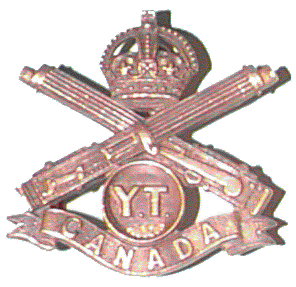

At the beginning of the First World War, the Canadian Minister of Militia
and Defence, Colonel Sam Hughes accepted offers of financial assistance from
several prominent citizens to raise four machine gun units. One of them was
the Yukon Motor Machine Gun Battery.
It was organized privately by Joseph Whiteside Boyle; better known as
Klondike Joe Boyle. Originally, it was to be a small force of 50 men with
horses and rapid firing guns. Recruiting began in Dawson City where they
were known as the "Yukon Boys". They were outfitted in khaki trousers and
woollen shirts to match, yellow mackinaws, and stiff brimmed sombreros.
Their cap badge consisted of crossed machine guns with a miner's pan on top
on which were superimposed the initials "YT" (Yukon Territory). Legend has
it that at least the first fifty men to enlist had an actual gold nugget in
the "pan".
While still in Dawson City, they were given some basic military training
and drilled by two RCMP officers. Boyle finally had them taken to Victoria
BC where he continued to pay for their upkeep until the Canadian government
took over the unit and moved them to Vancouver. By that time, they were
listed as a machine gun section to the 2nd Canadian Mounted Rifles. They
went overseas to the UK with that regiment in May 1915.
When in the UK, the Yukon Battery was amalgamated for a short time with
one of the other four units; the Borden Battery. By June 1916, the Yukon's
total strength had dwindled to 34 men. It was then sent to the Canadian
Machine School as a prelude to being attached to 4th Canadian Infantry
Division. In August 1916, having received it's complement of Armoured
Autocars and other equipment, it was sent to France to join the 4th
Division. It fought with 4th Division until December 3, 1916 when it finally
joined the other motor machine gun batteries in what was known as 1st
Canadian Motor Machine Gun Brigade (1stCMMGB).
The Brigade fought as machine gunners in all of the major battles that
Canadians participated in such as Vimy Ridge and Passchendaele among others.
They also supported many different British formations.
On June 8, 1918, the Brigade was reorganized with the addition of new
units and it was split into two brigades, the 1st and 2nd CMMGB. The Yukon
Machine Gun Battery was moved to 2nd CMMGB and fought with that unit to the
end of the war. Both brigades came into their own during the desperate
German offensive of 1918 where they moved throughout the battlefield in
their armoured Autocars providing machine gun support wherever required.
On my STEEL CHARIOTS web site is a page on the Armoured Autocar; the
vehicle your grandfather may well have fought in if he was a machine gunner.
To read that page, go to the "Armoured Vehicle Profile" page and scroll down
to "Armoured Autocar".